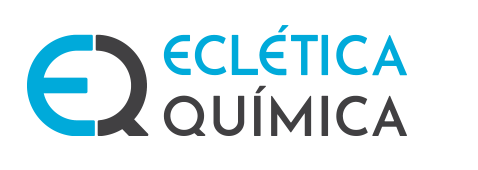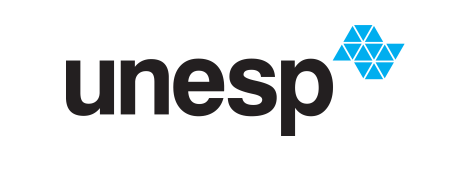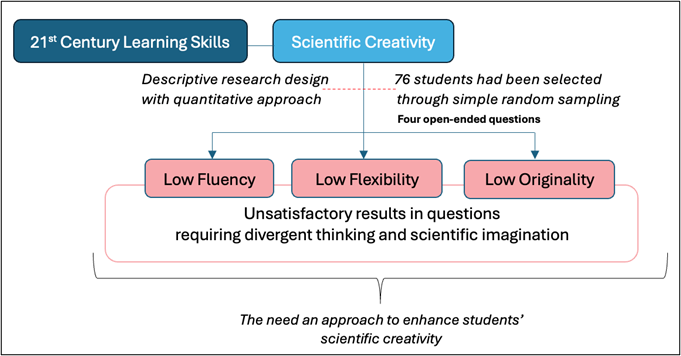Abstract
The significance of scientific creativity in science has been highlighted for nearly two decades. In chemistry education, this involves students’ ability to generate concepts related to chemical problems and phenomena, such as the colloid system found in daily life. Understanding the colloid system requires students to produce scientific ideas for problem-solving. Therefore, assessing students’ scientific creativity is crucial. This research aimed to determine students’ scientific creativity concerning the colloid system using a descriptive, quantitative approach. Seventy-six students were selected through simple random sampling. Data collection involved four open-ended questions, analyzed using a scoring rubric and percentage scores. The study revealed that students’ fluency, flexibility, and originality were low, leading to unsatisfactory results in questions requiring divergent thinking and scientific imagination. These findings highlight the need to enhance students’ ability to generate scientific ideas, emphasizing the importance of fostering scientific creativity in education.
References
Antink-Meyer, A.; Lederman, N. G. Creative Cognition in Secondary Science: An exploration of divergent thinking in science among adolescents. Int. J. Sci. Educ. 2015, 37 (10), 1547–1563. https://doi.org/10.1080/09500693.2015.1034523.
Arini, N. R.; Sabang, S. M.; Diah, A. W. M. Implementation of Guided Inquiry Learning Model on Colloid Systems to Improve Critical Thinking Ability of Students. Jurnal Akademika Kimia. 2021, 10(2), 87–92. https://doi.org/10.22487/j24775185.2021.v10.i2.pp87-92.
Arma, S.; Supriadi, S. Analysis of Student’s Creative Thinking Ability on Colloid Material. J. Akad. Kim. 2022, 11 (1), 1–5. https://doi.org/10.22487/j24775185.2022.v11.i1.pp1-5
Beers, S. Z. What are the skills students will need in the 21st century? 2011, pp. 1–6.
Chan, S.; Yuen, M. Creativity beliefs, creative personality and creativity-fostering practices of gifted education teachers and regular class teachers in Hong Kong. Think. Skills Creative. 2014, 14, 109–118. https://doi.org/10.1016/j.tsc.2014.10.004
Demir, S. Assessment of prospective science teachers’ metacognition and creativity perceptions and scientific toys in terms of scientific creativity. Procedia - Social and Behavioral Sciences. 2014, 152, 686–691. https://doi.org/10.1016/j.sbspro.2014.09.263
Gunawan, G.; Nisrina, N.; Suranti, N. Enhancing Students’ Creativity in Physics Classroom using Virtual Laboratory. Ictte. 2018, 262, 362–366. https://doi.org/10.2991/ictte-18.2018.67
Hairida, H. Using Learning Science, Environment, Technology and Society (SETS) Local Wisdom and based Colloids Teaching Material. J. Educ. Teach. Learn. 2017, 2 (1), 143–148. https://doi.org/10.26737/jetl.v2i1.146
Hasanah, N.; Sutarto, S.; Nuriman, N.; Budiarso, A. S. = STEM-CP (Science, Technology, Engineering, Mathematics, and Contextual Problem) Based Colloid Textbook to Increase Creative Thinking Skill for Chemistry Learning in Senior High School. Pancaran Pendidikan. 2020, 9 (1), 73–80. https://doi.org/10.25037/pancaran.v9i1.274
Hayati, D. K.; Sutrisno, S.; Lukman, A. Pengembangan Kerangka Kerja TPACK pada Materi Koloid untuk Meningkatkan Aktivitas Pembelajaran dalam Mencapai HOTS Siswa. Edu-Sains: Jurnal Pendidikan Matematika Dan Ilmu Pengetahuan Alam, 2014, 3 (1), 1776. https://doi.org/10.22437/jmpmipa.v3i1.1766
Hu, W.; Adey, P. A scientific creativity test for secondary school students. Int. J. Sci. Educ. 2002, 24 (4), 389–403. https://doi.org/10.1080/09500690110098912
Ikiao, E. K. K. Effect of Discovery Teaching Approach on Scientific Creativity Amongst Students of Chemistry In Public Secondary Schools In Imenti North Sub-County, Kenya. Doctoral dissertation, Chuka University, 2019.
Isbullah, I.; Supardi, K. I.; Jumaeri, J. The Influence of Project-Based Learning Model to Improve Students’ Creative Thinking on Colloid Subject. Journal of Innovative Science Education. 2019, 9 (37), 1–5.
Jamal, S. N. B.; Ibrahim, N. H. B.; Halim, N. D. B. A.; Alias, M. I. Bin. A preliminary study on the level of creativity among chemistry students in district of Melaka Tengah. J. Crit. Rev. 2020, 7 (16), 752–761.
Kamonjo, F. Creativity Level in Chemistry Education by Gender Among Secondary School Students in Kenya. J. Educ. Pract. 2019, 10 (20), 50–60. https://doi.org/10.7176/JEP/10-20-07
Kanematsu, H.; Barry, D. M. STEM and ICT Education in Intelligent Environments. Intelligent Systems Reference Library, 2016, 3–7. https://doi.org/10.1007/978-3-319-19234-5
Kirimi, D. O.; Wanja, M.; Barchok, H.; Jagero, N. Effectiveness of Integrating Science Process-Skills in Teaching Mathematics on Students’ Achievement in Secondary Schools in Tharaka-Nithi County, Kenya. Int. J. Acad. Res. Prog. Educ. Dev. 2017, 6 (4), 111–121. https://doi.org/10.6007/IJARPED/v6-i4/3533
Liang, J. C. Exploring scientific creativity of eleventh-grade students in Taiwan. Thesis, The University of Texas at Austin, 2002.
Nakano, T. C.; Wechsler, S. M. Creativity and innovation: Skills for the 21st century. Estud. Psicol. (Campinas). 2018, 35 (3), 237–246. https://doi.org/10.1590/1982-02752018000300002
O’Donoghue, D. P.; Saggion, H.; Dong, F.; Hurley, D.; Abgaz, Y.; Zheng, X.; Corcho, O.; Zhang, J. J.; Careil, J. M.; Mahdian, B.; Zhao, X. “Towards DR inventor: A tool for promoting scientific creativity”, Proc. 5th Int. Conf. Comput. Creativity, ICCC 2014. 2014.
Obote, D. K. Effectiveness of Integrating Science Process Skills in Teaching Mathematics on Students’ Scientific Creativity in Secondary Schools in Tharaka Nithi County, Kenya. Int. J. Acad. Res. Prog. Educ. Dev. 2016, 5 (4), 111–121. https://doi.org/10.6007/IJARPED/v6-i4/3533
Omar, S. S.; Harun, J.; Halim, N. D. A.; Surif, J.; Muhammad, S. Investigating the level of scientific creativity of science students. Adv. Sci. Lett. 2017, 23 (9), 8247–8250. https://doi.org/10.1166/asl.2017.9870
Park, J.-W. A Suggestion of Cognitive Model of Scientific Creativity (CMSC). J. Korean Assoc. Sci. Educ. 2004, 24 (2), 375–386.
Runco, M. A.; Acar, S. Divergent Thinking as an Indicator of Creative Potential. Creat. Res. J. 2012, 24 (1), 66–75. https://doi.org/10.1080/10400419.2012.652929
Soland, J.; Hamilton, L. S.; Stecher, B. M. Measuring 21st century competencies: Guidance for educators. Asia Soc. Global Cities Educ. Network Rep. 2013, 1–64.
Sulastri, F.; Utami, L.; Octarya, Z. Pengaruh Penerapan Model Pembelajaran Inkuiri Terbimbing (Guided Inquiry) Berbantuan Lembar Kerja Siswa Terhadap Kemampuan Berpikir Kreatif Siswa Pada Materi Koloid. Konfigurasi J. Pendidik. Kim. Dan Terapan 2019, 3 (1), 15–22. https://doi.org/10.24014/konfigurasi.v3i1.6802
Sumarni, W.; Kadarwati, S. Ethno-stem project-based learning: Its impact to critical and creative thinking skills. Jurnal Pendidikan IPA Indonesia. 2020, 9 (1), 11–21. https://doi.org/10.15294/jpii.v9i1.21754
Sun, M.; Wang, M.; Wegerif, R. Effects of Divergent Thinking Training on Students’ Scientific Creativity: The Impact of Individual Creative Potential and Domain Knowledge. Thinking Skills and Creativity. 2020, 37, 100682. https://doi.org/10.1016/j.tsc.2020.100682
Suyidno, Nur, M.; Yuanita, L.; Prahani, B. K.; Jatmiko, B. Effectiveness of creative responsibility-based teaching (CRBT) model on basic physics learning to increase student’s scientific creativity and responsibility. J. Baltic Sci. Educ. 2018, 17 (1), 136–151. https://doi.org/10.33225/jbse/18.17.136
Tirri, K.; Cho, S.; Ahn, D.; Campbell, J. R. Education for Creativity and Talent Development in the 21st Century. Educ. Res. Int. 2017, 1–2, 5417087. https://doi.org/10.1155/2017/5417087
Ulfah, A.; Rusmansyah; Hamid, A. Improving Self-Efficacy and Creative Thinking Ability Students Through the Project Based Learning Model on Colloidal Material. JCAE (J. Chem. Educ.) 2020, 3 (3), 90–96. https://doi.org/10.22202/economica.2020.v9.i1.4250
Wahyu, W.; Rusmansyah, R.; Sholahuddin, A. Meningkatkan Kemampuan Berpikir Kreatif Dan Self Efficacy Siswa Menggunakan Model Creative Problem-Solving Pada Materi Sistem Koloid. Vidya Karya. 2017, 32 (1), 36–44. https://doi.org/10.20527/jvk.v32i1.4147
Wahyuliani, D.; Danial, M.; Sanusi, W. Pengembangan E-Modul pada Materi Koloid untuk Meningkatkan Kemampuan Berpikir Kreatif Peserta Didik. Chem. Educ. Rev. 2022, 5 (2), 207–215. https://doi.org/10.26858/cer.v5i2.32732
Wang, J.; Yu, J. Scientific creativity research based on Generalizability Theory and BP-Adaboost RT. Procedia Eng. 2011, 15, 4178–4182. https://doi.org/10.1016/j.proeng.2011.08.784
Zulkarnaen, Z.; Supardi, Z. I.; Jatmiko, B. The Role of Knowledge Mastery and Science Process Skills to Increase the Scientific Creativity. Unnes Sci. Educ. J. 2018, 7 (2), 178–185. https://doi.org/10.15294/usej.v7i2.23320

This work is licensed under a Creative Commons Attribution 4.0 International License.
Copyright (c) 2025 Eclética Química








